The Gold Coast
Our work in Ghana is finished, though the projects themselves are just begun.
I think we’ve made some difference with Aid to Artisans. They now have a very comprehensive analysis of their producers’ chain of supply from raw material to end consumer, video documentation of same, a set of recommendations on revamping their website including a redesign, and a roadmap for e-commerce. I’m pleased.
I’m also exhausted, and dirty, and homesick. But there’s one last adventure. I’m headed to Kenya tomorrow for a four-day safari on the Masai Mara, edge of the Serengeti. It’s a tent trek: no electricity, running water, or (can you believe it?) net access. Leaving all my gadgets in Accra. Offline, gridless, naked.
I have so much more to write about Ghana. Amazing fishing villages, a visit to a voodoo shrine, and playing in a tennis tournament as the only obruni. But it’ll all have to wait.
Thanks for reading this past month. Back in the fold after the safari!
(Full photo and video set is here, if you’re interested.)
Brass
Part six (of six) of the Ghanaian Handicraft series.
I’ve left the most complex handicraft until the end. I’m ashamed to admit how long it actually took me to figure out just what the heck was going on. A metallurgist, I’m not. But it is also arguably the coolest craft I learned. Here’s why.
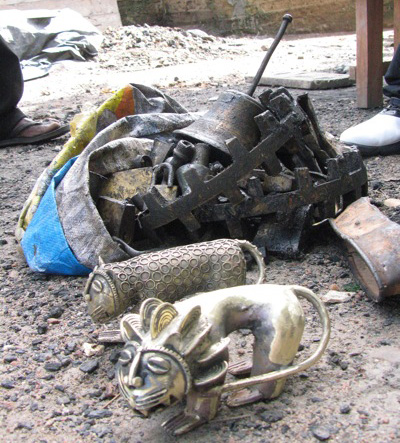
Brass artisans take take the trash of technology — gears, circuit boards, wires, pipes — and transform it into art. It seems so right — such a fitting way to repurpose what otherwise would be non-biodegradable and in some instances toxic. (Glass bead artisans do something similar with discarded bottles.)
Specifically brass workers strip zinc and copper where it can be found and, though the level of impurity is high, they’re able to forage quite a bit.
But let’s back up. Making brass is relatively easy compared to getting it into the shape you want. Basically the art in this craft is all about the mold. It starts with long strings of honeybee wax. How the wax is shaped is exactly how the envisioned product will look. That is, where wax is in your model is where the liquid brass will harden. So get it right.
Charcoal is the material around which or through which you place the wax. It holds things in place. So, as in the video above let’s say you are making hollow, decorative spheres (for a necklace, for instance). A charcoal ball at the middle supports the wax decoration which will eventually becomes the brass.
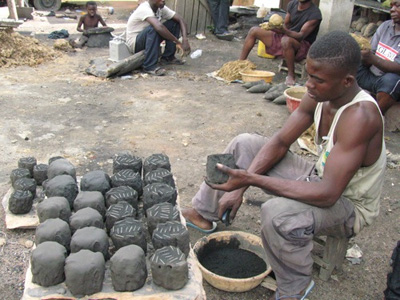
OK, follow me on this. It hurts the brain a bit. Charcoal is packed around the finished wax model too. So basically you have the shape of the final product, in wax, completely surrounded by charcoal. Then this is all encased in a mud and straw crucible.
The key to it all is that there is no wax isolated completely inside the crucible. It all touches some other wax and is finally connected to strands of wax that poke out of the charcoal. See where this is going?

The crucibles are heated around a fire and the wax melts. It is drained out — thanks to nothing being isolated and the “channels” of wax that stick out of the mold. What you have is a perfect inverse mold of what you’re trying to make. Just pour in the brass (melted obviously) and let it set. Chip away the charcoal and voila! Brass from trash.

More brass-making video here.
Sally Struthers go home
Been struggling with how to put into words something I’ve felt visiting the poorer areas of Ghana.
Like most Westerners my concept of poverty in Africa is heavily informed by aid campaign advertisements. (I blame Sally Struthers completely.) Pre-programmed, one just sort of expects to find misery and unhappiness: sobbing, curled children with distended bellies; emaciated frowns from doorways; a total lack of joy.
I have seen none of this. In fact, if there’s any emotion I see more frequently than others it is happiness.
Now, before you say that I have confined myself to upscale, urban areas, I’ll note that most of the first two weeks’ work was in the field in tiny villages without electricity, running water, or any infrastructure whatsoever.
Certainly there is much misery and want in Africa. Failed states, pestilence, warfare — take your pick. But the longer I am in Africa the more I realize that we’ve been conditioned to believe that Africans are not happy. Purely from a aid organization sales perspective this makes sense: if people are happy with their plight in Africa why send your support check in?
It comes down to this: standard of living is not the same thing as quality of life. Would Ghanaians love to have other amenities that first-world citizens enjoy? Perhaps. Are they in abject misery because they do not? No way.
In thinking that Ghanaians’ quality of life suffers because their standard of living is below ours we’re making a cliched blunder, guessing at the perspective of someone else through the filter of your own cultural sensibilities. It’s arrogant. And demonstrably incorrect.
Africa could use help, there’s no doubt. But aid will never be effective if we provide it based on caricatures of behavior meant to tug at us emotionally. So, Sally, go home. I know children lack food and die of horrible illnesses in Africa. But images like that mask the real complexity of the needs and promise of African society. Let’s be more honest.
Clay
Part five of the Ghanaian Handicraft series.
As in many cultures, pottery is made from clay in Ghana. Yet as a craft it is hard to find here, largely because it is considered utilitarian, with a market that’s almost completely domestic. People use the pots, bowls, and vessels in everyday life.

Unlike other handicraft that is created at some distance from the source of the raw materials, potting happens close to the river banks that provide the clay, presumably because it’s a pain to move large quantities of the dense, wet material.
We visited the tiny village of Nfensi and were taken to their river. It was one of those glad-I-took-my-malaria-meds moments. (Luckily we were there during the daytime, before the virus-toting Anopheles skeeters come out.)
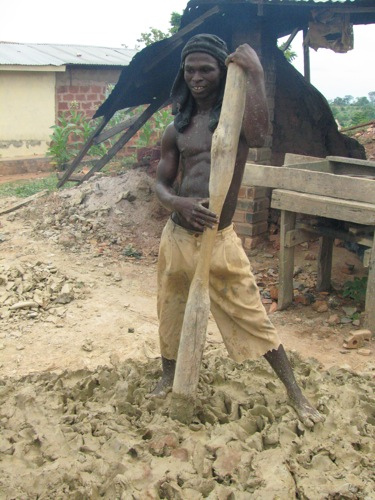
Once hauled up from the water the clay is pounded repeatedly to loosen it up. (The pounder uses the same tool that smashes open yam and cassava for fufu, incidentally.) There’s a further step of kneeding, then the potter slices off as much clay as he’ll need and slaps it on the wheel.
The potter’s wheel is completely manual. One guy cranks it while the master shapes the clay.
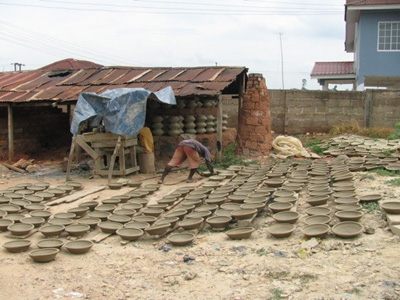
It happens so quickly and effortlessly — probably not surprising given that they turn out approximately 1,000 items every three days.
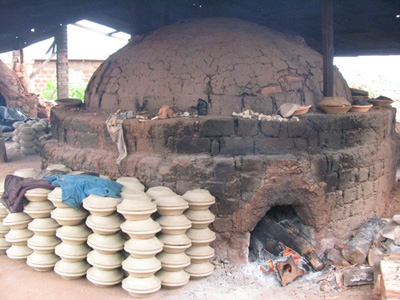
Once dried, the clay objects are prepared for the igloo-shaped kiln. It’s infernally hot around the oven which the artisans actually walk into to stack the clay pots. Then the “door” to the oven is bricked up and the fire is allowed to go for a few days. The door gets broken back down and out come the finished, though unadorned pieces.
There is an export market that consumes larger, more finely decorated pieces, but it is overshadowed by the more “traditional” wooden export market. To many Westerners, Africa means wood carvings (masks, statues, etc). But those consumers who are interested in owning the most “real” African goods — what one study calls “authenticity buyers” — might look to pottery as an alternative.
More clay pottery video here.
Ghana One: Who’s Who?
With the final week upon us I thought I’d introduce you to my teammates from the inaugural IBM Corporate Service Corps mission in Ghana. (Update: I added myself.)

Ritu Bedi
Alias: Sweet Mango
Home: Delhi, India
Primary Skill: Breakfast negotiation.
Little-known fact: Acid reflux almost caused Ritu to bail out of the Kakum Canopy Walk.
More on Ritu’s assignment.

Arindam Bhattacharyya
Alias: Hookah
Home: Kolkata, India
Primary Skill: Has a sixth sense for locating good Indian food anywhere on the planet.
Little-known fact: Arindam can eat more than you. Try him.
More on Arindam’s assignment.

Roslyn Docktor
Alias: Happy Camper
Home: Washington, DC, USA
Primary Skill: Clipper-based hairdressing.
Little-known fact: She’s been to Zambia. No really, just ask her!
More on Roslyn’s assignment.

Pietro Leo
Alias: Tee Wee
Home: Bari, Italy
Primary Skill: Injecting humor when it is least expected or appropriate.
Little-known fact: Looks equally crazy when clean-shaven.
More on Pietro’s assignment.

Julie Lockwood
Alias: Gertie
Home: Boulder, CO, USA
Primary Skill: Can frighten small Ghanaian children to tears simply by looking at them.
Little-known fact: Has visited 90% of the toilets and “near-toilet experiences” in Ghana.
More on Julie’s assignment.

Fred Logan
Alias: Chief
Home: Ottawa, Canada
Primary Skill: Capital infusion to the local souvenir and handicraft industries.
Little-known fact: Taught disco dancing in the 1970’s — even appeared on TV.
More on Fred’s assignment.
Stefan Radtke
Alias: Shortwave
Home: Bonn, Germany
Primary Skill: Can speak in morse code.
Little-known fact: Set up a full shortwave radio station at our hotel.
More on Stefan’s assignment.

John Tolva
Alias: Mule
Home: Chicago, IL, USA
Primary Skill: Perspires more than his body weight every four hours.
Little-known fact: With enough tin foil, Stefan’s shortwave antenna, and an intricate yoga pose John can steal wireless from the hotel down the street.
More on John’s assignment.

Charlie Ung
Alias: Flip-Flop
Home: Vancouver, Canada
Primary Skill: Imperturbable.
Little-known fact: To mosquitos Charlie is mostly a bony frame transporting a big bag of delicious blood.
More on Charlie’s assignment.

Peter Ward
Alias: Biscuit
Home: Warwick, England
Primary Skill: Extraordinarily detailed blogging.
Little-known fact: Peter has wireless access in his room and, as such, is the object of a team conspiracy to abduct and relocate him.
More on Peter’s assignment.
IBM@10
Today I mark one decade in the full-time employ of IBM. No, I don’t believe it either.
Back in 1998, as the go-go days of the first boom were about to go-go away, I was struggling between two job offers. IBM’s was low, a producer role at the relatively iconoclast Interactive Media group in Atlanta. The other, with a start-up consultancy called iXL, was much sexier, promising a higher salary and 10,000 options (oh, the promises).
To this day I don’t really know why I chose IBM. Might have been the I in the acronym — the suggestion of a career spent globetrotting and doing business in different cultures. Which is precisely what it turned out to be, though I’ve taken the jetsetting to some kind of perverse extreme. Being in Africa while marking this “anniversary” rather puts an exclamation point on it.

My first office space, IBM Interactive Media, Atlanta
10 years is a completely arbitrary duration of time, but it does feel important somehow. More important than the extra week of vacation, that is. (Seriously, does anyone count vacation days anymore?)
I’d known since the beginning of the year that I wanted to use the anniversary as an evaluation point. And then the Corporate Service Corps opportunity came up I thought, what a perfect way to evaluate my career than to be yanked out of it for a month and plopped into a wholly unfamiliar environment.
With two weeks to go in Africa, I have no stunning insights to share as yet. I suppose if any do come it will be when I am back in the US and can reflect a bit. I do know what I miss and what I don’t (a future post, of course), but as for what I want to be when I grow up … still thinking firefighter, librarian, or World Dictator. Will let you know how it all turns out. (By the way, for those interested in what it is I actually do you can learn more here.)
So how did I celebrate this occasion? I waited until shortly after midnight last night, silently marked the anniversary, went over to the pool, and jumped in fully dressed. Seemed appropriate somehow.
Textile
Part four of the Ghanaian Handicraft series.
Few crafts are as closely linked with their place of production than kente cloth weaving is with Ghana. Tradition holds that five villages in the Ashanti region were declared official kente-weaving centers by the first king of Kumasi. Only two of these villages still produce the textile and of these Bonwire (pronounced bon-RAY) is the most famous.
The colored yarn is imported — a rare example of an international supply dependency in Ghanaian handicraft. This may be more a sign of market demand for the widest range of color and, as such, would be a positive thing, evidence of adaptability in an ancient form.
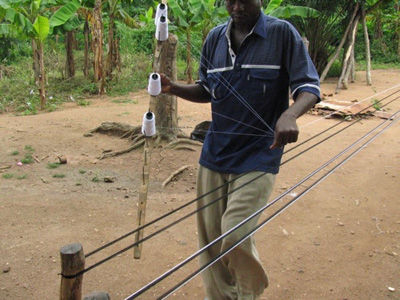
Before being placed on the loom, individually-colored yarn strands are reeded and warped in open outdoor spaces. This basically consists of mixing the colors together manually (by drawing out precise lengths then painstakingly intertwining separate colors) so that the weavers have the color elements pre-assembled when they insert it into the loom. It’s warp and weft sous-cheffing.

Though mass-produced kente can be churned out from automated looms, the traditional setup is a wooden box that fully engages the limbs of the operator. Feet press on make-shift pedals to raise and lower the separate planes of fabric (which form the kente background) while one hand flits the bobbin of thread in and out (which creates the actual design). The other hand variously adjusts the comb that pounds the new threads into place and a separator that gives the bobbin more room to work. It happens fast.
It’s mesmerizing really, high-technique, high-speed, and in full color. (There’s high tech too. New designs and particularly complex patterns are designed first using a custom computer application. There’s no automation involved, just a pre-design that when printed helps the weavers understand the sequence of overlapping shapes needed to make the end design.)
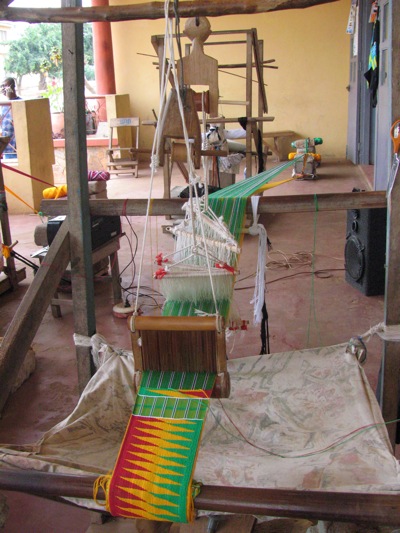
Men — and it is always men, traditionally — work at the looms side-by-side. There’s no talking, no singing, maybe a radio on, but basically just the hypnotic squeak and wooden clatter of the looms.
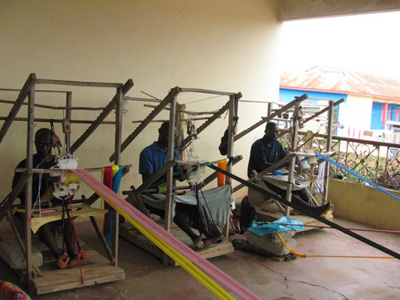
Typically a single 8″ by 5′ section of kente takes a month or more to finish. Sections are sewn together and sold in larger pieces as traditional Ashanti tunics or for Western uses such as duvets and throws.
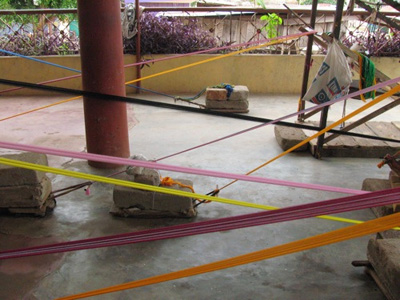
To come across a workshop in Bonwire is to enter a world of bold geometries and colors — a vibrant contrast to the matte earth tones of what is otherwise a fairly poor village.
There’s a cultural center outside of Bonwire that’s totally deserted. (It has a relatively clean toilet; we’ve stopped there twice.) Clearly this was the town’s attempt at capitalizing on its famed craftsmanship — but that plan seems to have run off the rails. If any craft village can become a tourist destination it is Bonwire. Our goal, in part, is to help Aid to Artisans figure out how to do this.
More textile-weaving video here.
A homecoming
Our great family friend Margaret Kumi has arrived in Kumasi from Chicago. I could not be happier (unless it were my own family who arrived). She’s brought a care package from home and familiarity — maybe the best package of all.
Sunday she and I head to the village of Tanoboase to meet the chief and see what can be done. (Backstory here.)
Abena Dekyi, Margaret’s sister-in-law, prepares homemade dishes for us in her home. Hands down the best meal I have had in three weeks. Yum!
Glass
Part three of the Ghanaian Handicraft series.
Glass beads are not an indigenous art form in West Africa. Today’s Ghanaian bead-makers continue a craft introduced by Europeans in the 15th century. Glass beads, made then primarily in Venice, were used as barter for the raw materials that Europeans desired. As glassmaking was not widespread in Africa the articles of fashion made from the beads were highly sought after and, in time, came to be called ‘trade beads,’ a de facto coin of the realm.
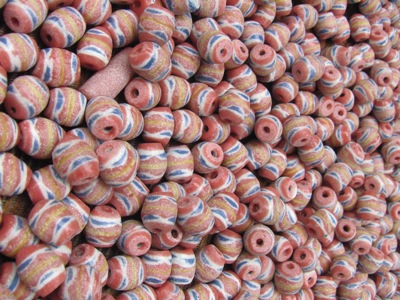
Trade beads were often swapped for slaves. You’ll also hear them referred to as ‘slave beads.’ Unlike some Westerners, contemporary artisans obviously find no dark irony in carrying on a craft meant initially to quantify the worth of a human being. And why should they? Like refusing to salt your fries because it too was once used to barter for slaves.

The “raw” materials for the bead-makers are discarded bottles. It’s a wonderful thing, really. At zero cost, the artisans collect up as much glass as they can (though, admittedly it is a bit tougher here than in the West because you can’t buy new bottles of soda, for instance, without returning an empty one). From trash to jewelry — can’t beat that product life-cycle.
The bottles are smashed. And smashed again. And again. Repeatedly until the glass is just a fine, pulverized powder. (Don’t inhale.)
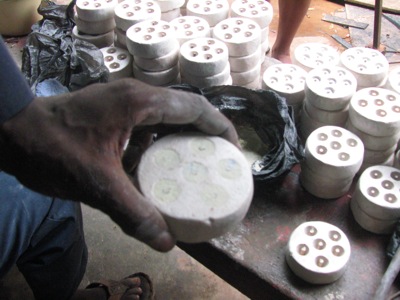
Once in powder form the glass is mixed with various dyes and filled into molds depending on the desired bead shape. Then, into hell’s oven for melting.

Typically the molds yield semi-circular halves which are then melted together to form spheres. They are then joined on a string, often with differently-colored beads, thanks to the central axle in the mold that preserves a hole through the bead.
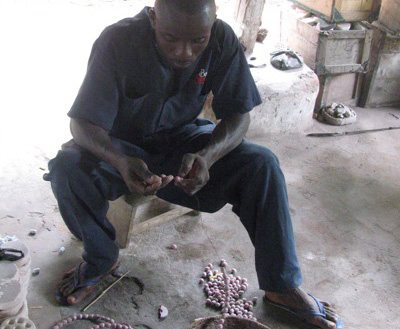
More bead-making video here.
Straw
Part two of the Ghanaian Handicraft series.
Straw weaving is not a craft normally associated with the environs of Kumasi. Mostly that honor belongs to the far northern town of Bolgatanga. (Say that word. Say it now. And enjoy how delightful it is to hear.) But we wanted to get a sense of the craft and it turns out that the actual raw material (the straw) is cheaper nearer to Kumasi. So some small artisans have sprung up.
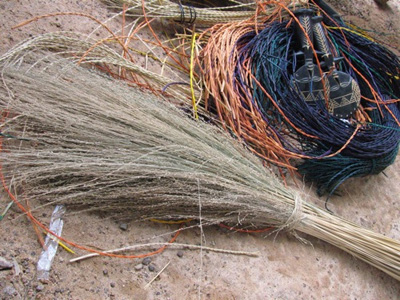
It’s the simplest craft we’ve observed. The most serene too. A single artisan with a bunch of straw strands, some dyed, sets out and weaves the object in mind. No tools; the very definition of handicraft and skill.
It’s a family affair in the small villages that produce straw-woven goods. Everyone seemed so damn happy, just weaving away. They know what they are doing, how to do it, and why they’re doing it. It was inspirational, in a way.
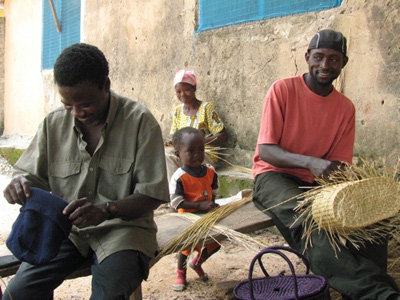
More straw-weaving video here.
















